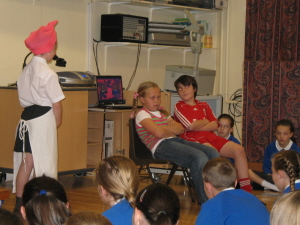5S Class Assembly |
Harvest Celebration |
Friday 5th October 2007 |
Each autumn at Forefield Junior School, we celebrate a Harvest Festival. This year, it was the turn of Miss Smith's Class to lead us in giving thanks for all the good things that we have. |
 |
People all over Great Britain celebrate the Harvest Festival in the Autumn. We give thanks for the food we eat and bring a small gift which is later given to people who are not as fortunate as us. |
In Nigeria, people celebrate with a fishing festival in February. It lasts for two days and marks the end of the fishing season. The celebration includes displays of bare-hand fishing, swimming and canoe racing. |
 |
 |
Hindus in India celebrate the sugar cane harvest in January. This is a time for parties and feasts, which include sweet puddings. |
The Chinese celebrate a mid Autumn festival in September. They go out at night with candles and lanterns, watch the full moon and pray for a good rice harvest. |
 |
 |
For countries in the southern hemisphere, such as New Zealand, the crops are harvested in February and March. |
Families share a special Thanksgiving dinner in the USA. It is traditional to eat a turkey – this reminds people of the Pilgrims fathers’ first successful harvest. |
 |
Have you ever moaned because you couldn't have exactly what you wanted to eat? That is how the two children behaved in a short drama (pictured right). They were being fussy and very ungrateful. During Miss Cain's visit to Sierra Leone, she learned that many of the children only ate one meal every other day! It is thoughts like this that should encourage to be grateful for all the food that we have, even if it isn't always to our taste! |
 |